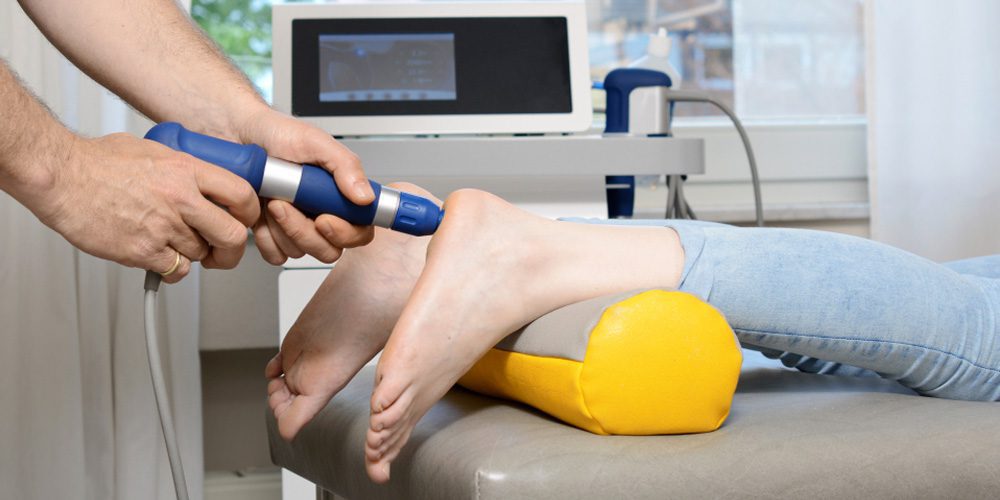Shockwave therapy, also known as extracorporeal shockwave therapy (ESWT), is a non-invasive medical treatment that utilizes high-energy sound waves to stimulate healing in various musculoskeletal conditions. These sound waves, also known as shockwaves, are generated by specialized devices and are transmitted through the skin to the affected area.
The primary purpose of shockwave therapy is to promote tissue regeneration and accelerate the body’s natural healing process. The concept behind shockwave therapy lies in its ability to deliver mechanical energy directly to the affected tissues.
By applying controlled shockwaves, this treatment stimulates increased blood flow, releases substances that reduce pain and inflammation, and triggers the production of collagen – an essential protein responsible for tissue repair. The focused energy delivered by shockwaves can target specific areas with precision, making it an effective option for treating localized injuries.
Brief History and Development of Shockwave Therapy
Shockwave therapy has an interesting history that dates back several decades. Originally developed in Europe during the 1980s as a method for breaking down kidney stones non-invasively (known as lithotripsy), researchers soon discovered its potential in treating musculoskeletal conditions. In the late 1990s, orthopedic specialists began using low-energy shockwaves to treat chronic tendon disorders such as plantar fasciitis and tennis elbow.
The results were promising, leading to further advancements in technology and treatment protocols over the years. Today, shockwave therapy has become widely recognized and accepted as a safe and effective non-surgical treatment option for various musculoskeletal ailments.
The development of different types of shockwave devices has played a crucial role in expanding the applications of this therapy. Initially, focused shockwaves were used primarily for orthopedic conditions; however, radial or pressure waves have gained popularity due to their versatility and ability to treat larger areas.
Furthermore, advancements in electromagnetic shockwave technology have opened doors for precise and targeted treatment. Overall, the history and development of shockwave therapy demonstrate a progressive journey of discovery, innovation, and adaptation.
The therapeutic potential of shockwaves continues to evolve, offering new hope for patients seeking alternative treatments to enhance their quality of life. Stay tuned for the next sections where we will delve deeper into understanding how shockwaves work and explore the wide range of applications this therapy has to offer.
Understanding Shockwaves
Shockwaves, in the context of therapy, are high-energy acoustic waves that can be generated artificially and applied to specific areas of the body. These waves consist of rapid changes in pressure, creating a mechanical force that targets damaged tissues or areas requiring stimulation.
When these shockwaves interact with the body, they initiate a cascade of biological responses that promote healing and regeneration. The shockwaves used in therapy are not to be confused with sound waves or ultrasound waves.
While sound waves travel through a medium like air or water, shockwaves behave differently as they contain significantly higher energy levels. They propagate through tissues uniquely, exerting mechanical forces on cells and causing microtrauma at the cellular level.
Different types of shockwaves used in therapy
In therapy, two primary types of shockwaves are commonly used: focused shockwaves and radial shockwaves. Focused Shockwaves:
Focused shockwave therapy employs an electromagnetic source to generate highly concentrated energy pulses that converge at a single focal point deep within the tissue. This type is particularly effective for treating localized musculoskeletal conditions such as tendinopathies and calcifications.
By precisely targeting specific regions, focused shockwave therapy maximizes its therapeutic benefits while minimizing potential side effects. Radial Shockwaves:
Radial (or extracorporeal) shockwave therapy disperses lower-energy acoustic pulses over a broader area without focusing on a single focal point. It involves applying these pulses directly to the skin’s surface above the affected area using an applicator device.
Radial shocks have shown positive results in various conditions such as plantar fasciitis and muscle strains. Radial shocks are less intense compared to focused shocks but still induce beneficial effects by promoting blood circulation, stimulating tissue repair mechanisms, and reducing pain sensitivity.
Healthcare professionals must determine the appropriate type of shockwave therapy based on the patient’s condition and specific needs. Through careful evaluation, they can choose between focused or radial shockwaves to ensure optimal treatment outcomes for their patients.
Mechanism of Action: How Shockwaves Interact with Tissues
When it comes to shockwave therapy, understanding the mechanism of action is crucial for appreciating its effectiveness. The treatment involves the application of high-energy acoustic waves to the affected area.
These waves are generated by a specialized device and directed towards the targeted tissue. As the shockwaves pass through the tissues, they create microtrauma at a cellular level, initiating a healing response.
The shockwaves used in therapy are characterized by their rapid rise time and high peak pressure. When these waves encounter diseased or injured tissues, they exert mechanical forces that stimulate various biological responses.
The energy from the shockwaves activates mechanoreceptors within cells and triggers a cascade of events leading to tissue regeneration. Furthermore, shockwaves promote angiogenesis, which is the formation of new blood vessels in damaged tissues.
This increased blood flow improves oxygen and nutrient supply to the area, aiding in cell repair. Additionally, it stimulates metabolic activity within cells and encourages collagen synthesis – an essential component for tissue strength and structure.
Effects on Cellular Level: Promoting Tissue Regeneration and Healing
At a cellular level, shockwave therapy exerts multiple beneficial effects that contribute to tissue regeneration and overall healing. One key effect is the increased production of growth factors within cells.
Growth factors play a vital role in regulating cell proliferation, differentiation, and migration – all crucial processes for repairing damaged tissues. Moreover, shockwave therapy enhances neovascularization – the formation of new blood vessels from pre-existing ones.
This process helps provide an adequate blood supply to injured tissues that may have been deprived of sufficient nutrients due to reduced circulation. Additionally, shockwaves stimulate mesenchymal stem cells (MSCs) present in our bodies’ connective tissues.
These specialized cells have remarkable regenerative potential as they can differentiate into various cell types involved in tissue repair. The activation of MSCs by shockwaves promotes their migration to the injured site and accelerates the healing process.
Furthermore, shockwave therapy has been shown to reduce pain and inflammation. It modulates pain receptors, decreases the release of pro-inflammatory mediators, and stimulates the production of anti-inflammatory substances.
This combined effect provides relief from pain associated with many musculoskeletal conditions. Overall, shockwave therapy works at a cellular level by initiating a series of biological responses that promote tissue regeneration and healing.
Through its mechanism of action, it harnesses the body’s innate healing capacity to treat various musculoskeletal ailments effectively. (Note: This article is for informational purposes only and does not constitute medical advice. Consult a healthcare professional for personalized treatment options.)
Applications of Shockwave Therapy
When it comes to musculoskeletal conditions, shockwave therapy has shown remarkable efficacy in treating a wide range of ailments. One of the most common conditions treated with this therapy is tendinopathy. Tendinopathy refers to the degeneration or inflammation of a tendon, often caused by overuse or repetitive strain.
This condition affects athletes, workers who perform repetitive motions, and even individuals with poor biomechanics. Shockwave therapy offers a non-invasive solution to alleviate pain and promote healing in tendinopathies.
Detailed Explanation of Tendinopathies and Their Treatment with Shockwave Therapy
Tendinopathies can occur in various parts of the body, such as the Achilles tendon, rotator cuff tendons, patellar tendon (jumper’s knee), and tennis elbow (lateral epicondylitis). The most promising aspect of shockwave therapy is its ability to stimulate tissue repair and regeneration by facilitating increased blood flow to the affected area. During a shockwave therapy session for tendinopathy, high-energy sound waves are targeted directly at the injured tendon.
These waves emit mechanical pressure that triggers cellular responses within the tissues. This process stimulates collagen production, enhances neovascularization (the formation of new blood vessels), and reduces pain by breaking down calcifications or scar tissue.
Patients usually require multiple sessions over several weeks to experience significant improvement in their symptoms. The treatment itself might cause some discomfort during application, but therapists can adjust the intensity based on individual tolerance levels.
Overview of Other Musculoskeletal Conditions that Can Benefit from This Therapy
Aside from tendinopathies like Achilles tendonitis or tennis elbow, shockwave therapy has demonstrated positive outcomes for various other musculoskeletal conditions as well. One such condition is plantar fasciitis, which affects the sole of the foot and leads to heel pain. Shockwave therapy can effectively alleviate pain and promote healing in this area by stimulating tissue regeneration.
Moreover, shockwave therapy has shown promise in treating stress fractures, bursitis, frozen shoulder (adhesive capsulitis), and even non-healing wounds. With its ability to accelerate tissue repair processes and reduce inflammation, this non-invasive treatment option offers a viable alternative to more invasive procedures or prolonged medication use.
Shockwave therapy has emerged as an effective treatment modality for a range of musculoskeletal conditions. Tendinopathies, such as Achilles tendonitis and tennis elbow, can greatly benefit from this therapy due to its ability to stimulate tissue repair and reduce inflammation.
Additionally, conditions like plantar fasciitis, stress fractures, bursitis, frozen shoulder, and non-healing wounds have also shown positive responses to shockwave therapy. By harnessing the power of sound waves, this treatment option provides a non-invasive solution that promotes healing and improves the overall quality of life for individuals suffering from musculoskeletal ailments.
Scientific Evidence: Benefits and Efficacy of Shockwave Therapy
When it comes to shockwave therapy, the scientific community has conducted numerous studies to assess its efficacy in treating various conditions. The results have been promising, showing positive outcomes for patients. One study published in the Journal of Orthopaedic Surgery and Research found that shockwave therapy significantly improved pain, function, and quality of life in patients with plantar fasciitis.
Another study published in the American Journal of Sports Medicine reported that shockwave therapy effectively reduced pain and improved shoulder function in individuals with calcific tendinitis. These findings are just a snapshot of the extensive research supporting the use of shockwave therapy.
Multiple clinical trials have demonstrated its effectiveness in treating tendinopathies such as Achilles tendonitis, tennis elbow, and patellar tendinopathy. Additionally, studies have shown positive results for other conditions like frozen shoulder and non-healing fractures.
Clinical Studies Demonstrating Positive Outcomes in Various Conditions
Let’s delve into some specific clinical studies that highlight the benefits of shockwave therapy. A randomized controlled trial published in The Journal of Bone & Joint Surgery examined patients with chronic proximal hamstring tendinopathy. The study concluded that shockwave therapy not only reduced pain but also improved function compared to a placebo group.
Another study focused on individuals suffering from erectile dysfunction (ED). Published in Therapeutic Advances in Urology, it demonstrated that low-intensity extracorporeal shockwave therapy (LI-ESWT) led to significant improvements in erectile function without any major side effects.
Furthermore, researchers investigating chronic non-healing wounds found that applying shockwaves stimulated wound healing by promoting angiogenesis (formation of new blood vessels) and neocollagenesis (production of new collagen). These findings were published in the Journal of Investigative Surgery.
Comparison with Other Treatment Modalities
In comparison to traditional treatment modalities, shockwave therapy offers several advantages. For instance, it is a non-invasive procedure that does not require surgery or anesthesia. This makes it a safer option for patients who have contraindications to surgical interventions or prefer non-surgical approaches.
Furthermore, shockwave therapy is more effective than conservative treatments such as physical therapy and medication alone. A systematic review published in the Archives of Physical Medicine and Rehabilitation concluded that shockwave therapy provided superior pain relief and functional improvement compared to other interventions for musculoskeletal conditions like plantar fasciitis and tennis elbow.
Importantly, shockwave therapy also offers potential cost savings by reducing the need for prolonged medication use or repeated doctor visits. While the upfront cost of the treatment may be higher than some alternatives, its long-term benefits can outweigh these expenses.
Scientific evidence from various clinical studies consistently supports the efficacy of shockwave therapy in treating a range of conditions. Its ability to alleviate pain, improve function, promote tissue regeneration, and offer advantages over traditional treatment modalities makes it an increasingly popular choice among healthcare professionals and patients alike.
Preparing for a Shockwave Therapy Session
Before diving into the exhilarating world of shockwave therapy, it is essential to undergo a thorough patient assessment. The assessment serves as a foundation for designing an effective treatment plan that caters to your specific needs.
During this process, your therapist will take the time to understand your medical history, previous injuries, and any ongoing health conditions that may impact the session’s outcome. Your therapist will likely ask you questions about your pain levels, its triggers, and how it affects your daily activities.
They might also conduct physical examinations to evaluate the range of motion and pinpoint areas of tenderness or inflammation. This holistic approach ensures that the therapy is tailored precisely to address your concerns.
Discussion on Contraindications and Precautions
While shockwave therapy has proven benefits for various musculoskeletal conditions, it may not be suitable for everyone. Your therapist will discuss contraindications and precautions to ensure your safety throughout the session.
Certain factors such as pregnancy, blood clotting disorders, open wounds or infections in the treatment area, as well as certain medications like blood thinners or corticosteroids, might restrict you from undergoing this therapy. Additionally, if you have metal implants near the targeted area or suffer from nerve damage or cancerous conditions in that region, alternative treatments may be explored.
Remember: honest communication with your therapist is crucial during these discussions. By providing accurate information about your health history and asking questions when in doubt, you empower yourself with knowledge and help create a safe environment for effective treatment.
Explanation of How to Manage Pain during the Session
Pain management during shockwave therapy sessions is an important aspect that often concerns patients. While some discomfort can be expected due to the nature of this treatment modality, steps can be taken to minimize any potential discomfort.
Your therapist will guide you through the process, explaining what sensations you may experience during the session. They’ll use a gel or oil on the skin to facilitate the smooth movement of the device and optimize its effectiveness.
The intensity of the shockwaves can be adjusted to ensure your comfort, as everyone’s pain tolerance varies. Additionally, communicating openly with your therapist is key.
If you feel any sharp or excessive pain during treatment, inform them immediately so they can make the necessary adjustments. Remember, their expertise lies in providing a comfortable and beneficial experience for you.
So, when stepping into a shockwave therapy session, rest assured that your therapist will assess you thoroughly, discuss contraindications and precautions with care, and help manage any discomfort along the way. This personalized approach ensures that your journey toward healing is nothing short of exceptional.
Types of Shockwave Devices Used in Therapy
When it comes to shockwave therapy, several different types of devices can be used to deliver these therapeutic shockwaves. The three main types are focused, radial, and electromagnetic shockwave devices.
Each type works in a slightly different way and is suited for specific treatment purposes. Focused shockwave devices are designed to deliver highly concentrated shockwaves directly to the affected area.
These devices use a parabolic reflector or an electromagnetic coil to focus the energy onto a specific point. This type of shockwave therapy is commonly used for treating conditions like chronic tendonitis or bone fractures.
The focused shockwaves penetrate deep into the tissues, stimulating cellular regeneration and promoting healing. On the other hand, radial shockwave devices emit shockwaves that spread out in a radial pattern from the device’s applicator tip.
Unlike focused devices that target a specific spot, radial shockwaves disperse throughout a larger area. This makes them suitable for treating conditions like plantar fasciitis or tennis elbow where the affected area may be more widespread.
Radial devices are often handheld and can easily be maneuvered across the skin during treatment sessions. An alternative type of device used in shockwave therapy is electromagnetic shockwave machines.
These machines differ from both focused and radial devices as they generate electromagnetic pulses instead of mechanical ones. Electromagnetic waves travel through tissues with minimal resistance and have been found effective in treating deep tissue pathologies such as non-healing fractures or avascular necrosis.
Comparison between portable devices vs. clinic-based machines
When it comes to choosing between portable shockwave therapy devices versus clinic-based machines, there are some key factors to consider based on individual needs and treatment settings. Portable shockwave therapy devices offer convenience and flexibility for both therapists and patients.
They are compact and lightweight, making them easy to transport and use in different locations. These devices often have adjustable energy levels, allowing therapists to customize treatment according to the patient’s tolerance and condition.
Portable devices are commonly used in sports medicine clinics, physiotherapy practices, or even by individual athletes for at-home treatment. On the other hand, clinic-based shockwave machines are generally larger and more powerful.
These machines are typically found in specialized healthcare facilities where a wide range of conditions are treated using shockwave therapy. Clinic-based machines often offer a broader range of treatment options with different applicator sizes and energy settings, allowing therapists to target various anatomical areas effectively.
Clinic-based machines also tend to have advanced technological features such as real-time imaging guidance or integrated cooling systems for better patient comfort during treatment sessions. Additionally, these machines may have higher energy outputs compared to portable devices, making them suitable for more severe or chronic conditions that require deeper tissue penetration.
The choice between portable shockwave therapy devices and clinic-based machines depends on various factors including portability requirements, treatment settings, and the nature of the condition being treated. Both options offer unique benefits but ultimately aim at delivering effective shockwave therapy for promoting tissue healing and pain relief.
The Role of the Therapist Providing Shockwave Therapy
When it comes to administering shockwave therapy, therapists must possess the appropriate qualifications and training. Firstly, a therapist should have a solid foundation in anatomy and physiology, as well as a deep understanding of musculoskeletal conditions commonly treated with shockwave therapy. This knowledge enables them to accurately assess patients and determine the most effective treatment plan.
Furthermore, therapists should have specialized training in shockwave therapy techniques. This training typically involves extensive hands-on experience under the guidance of experienced practitioners.
It ensures that therapists develop the necessary skills to correctly position the shockwave device and adjust its settings according to individual patient needs. In addition to technical knowledge, therapists must also possess excellent communication skills.
They need to effectively explain the procedure to patients, address any concerns or questions they may have, and provide guidance on post-treatment care. Compassion and empathy are essential qualities for therapists when working with patients who may be experiencing pain or discomfort.
Training process for therapists to ensure safe and effective application
The training process for therapists seeking to administer shockwave therapy typically involves both theoretical instruction and practical experience. Therapists undergo comprehensive courses that cover topics such as the physics of shockwaves, indications, and contraindications for treatment, device maintenance, and patient management. During practical training sessions, therapists work closely with experienced practitioners who guide them through various aspects of administering shockwave therapy.
This includes learning proper hand positioning techniques, adjusting treatment parameters based on patient responses, managing potential side effects, and ensuring overall safety during the session. To further enhance their competency in this modality, ongoing professional development is also essential for therapists.
Attending workshops, conferences, or seminars related to shockwave therapy allows practitioners to stay updated on emerging research findings and advancements in technology, ensuring that they provide the most current and effective treatment options to their patients. Therapists should also be familiar with guidelines and standards set by relevant professional organizations in their respective countries.
Adhering to these guidelines ensures that therapists follow best practices and maintain a high level of professionalism while providing shockwave therapy. Therapists administering shockwave therapy must have the necessary qualifications and training to ensure safe and effective application.
A solid foundation in anatomy, physiology, and an understanding of musculoskeletal conditions is vital. Specialized training in shockwave therapy techniques, along with excellent communication skills, allows therapists to deliver optimal care to their patients.
The training process involves theoretical instruction as well as hands-on practical experience under the guidance of experienced practitioners. Ongoing professional development is crucial for therapists to stay updated on advancements in this field and maintain the highest standards of practice.
Potential Side Effects
During shockwave therapy, it is essential to be aware of potential side effects that may occur. While the majority of patients experience no adverse effects or only minor discomfort, it is crucial to have a comprehensive understanding of the possible outcomes.
Some patients might encounter transient and mild side effects, which typically subside shortly after treatment. These can include redness, bruising, swelling, or increased sensitivity in the treated area.
Rare and Severe Side Effects
Although rare, there have been reports of more severe side effects associated with shockwave therapy. These include skin blistering or burns due to improper application or high energy levels used during treatment.
Therapists need to follow proper guidelines and ensure patient safety at all times. Additionally, patients with certain medical conditions such as blood clotting disorders or severe neuropathy should consult their healthcare provider before undergoing shockwave therapy.
Managing Side Effects
To minimize potential side effects and enhance the overall safety of the treatment, therapists carefully assess patients before proceeding with shockwave therapy. By conducting a thorough evaluation beforehand, they can identify any contraindications or precautions that need to be taken into consideration. Furthermore, therapists can adjust the intensity level and dosage of shockwaves based on individual patient needs to optimize results while minimizing discomfort.
Consultation and Open Communication
Open communication between patients and therapists is paramount throughout the entire process of shockwave therapy. Patients should feel comfortable discussing any concerns or unusual sensations they experience during or after treatment sessions. By maintaining an open line of communication with their therapist and promptly reporting any unexpected symptoms, patients can receive timely guidance and support in managing potential side effects.
Conclusion
Shockwave therapy has emerged as a promising non-invasive treatment option for various musculoskeletal conditions. With its ability to stimulate tissue regeneration and accelerate healing, it offers patients the opportunity to potentially avoid surgery or rely less on medication. While potential side effects exist, they are generally mild and rare, especially when the therapy is administered by qualified professionals who follow established guidelines.
As research continues to uncover new applications and refine treatment protocols, shockwave therapy holds great promise for improving the quality of life for individuals suffering from musculoskeletal ailments. Whether it’s tendinopathies, plantar fasciitis, or other conditions affecting the joints and soft tissues, shockwave therapy provides a safe and effective alternative.
The potential benefits outweigh the minimal risks associated with this innovative therapeutic approach. So if you find yourself struggling with a chronic musculoskeletal condition that interferes with your daily activities or sports performance, don’t hesitate to explore the possibility of shockwave therapy.
Consult with a skilled professional who can assess your specific needs and determine if this treatment could be beneficial for you. Embrace the opportunity to embark on a journey of healing and rejuvenation that may enable you to regain your optimal physical well-being.





















